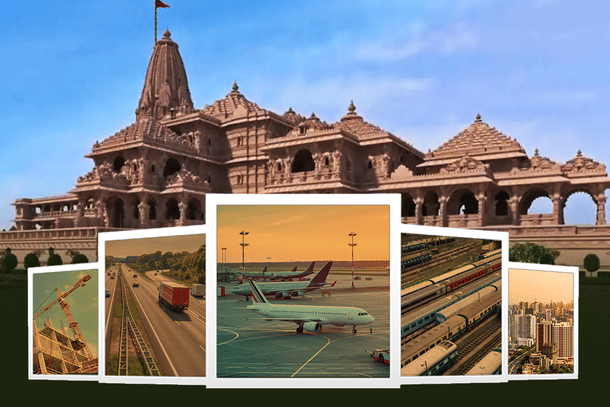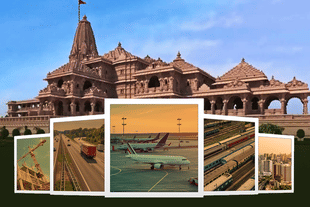Culture
Beyond The Mandir: Ayodhya’s Winding Journey To Becoming A Tourist Hub
Nishtha Anushree
Jan 22, 2025, 09:14 AM | Updated Jan 24, 2025, 06:31 PM IST
Save & read from anywhere!
Bookmark stories for easy access on any device or the Swarajya app.


In the year since the pran pratishtha of the Ram Janmabhoomi Mandir on 22 January 2024, Ayodhya has not only seen the highest footfall of tourists in Uttar Pradesh (UP) but has also become one of the most-discussed topics in political discourse.
For decades, Agra was the top tourist destination in UP, thanks to the iconic Taj Mahal. For the first time ever, Ayodhya replaced it by attracting 13.55 crore tourists between January and September 2024. In contrast, Agra had 12.51 crore tourists.
However, Agra remained the top destination for international tourists, with 9.24 lakh foreign visitors, far exceeding the 3,153 international tourists who visited Ayodhya.
The upswing in tourism is felt by locals who acknowledge that the development for tourists is benefitting them as well, bringing many employment opportunities to the temple town.
"Roads are much better now due to development. The average income has increased due to tourism," an Ayodhya resident, Praveen Sahu, who works a 9-to-5 job, told Swarajya.
He also refuted allegations that tourism is only benefitting outsiders, stating, "When development takes place, people from outside also come to take advantage, so 100 per cent benefits cannot be claimed by locals."
In terms of development, Ayodhya has been the biggest beneficiary of improved rail and air connectivity.
For instance, Ayodhya did not even have an operational airport until weeks before the Ram Mandir inauguration.
Since Prime Minister Narendra Modi inaugurated Maharishi Valmiki International Airport on 30 December 2023, Ayodhya now has direct air connectivity with six Indian cities: Delhi, Mumbai, Ahmedabad, Bengaluru, Chennai, and Hyderabad.
On average, 10 to 11 flights operate daily to and from Ayodhya, serviced by three airlines: IndiGo, SpiceJet, and Air India Express. While Ayodhya airport can handle 10 lakh passengers annually, its capacity is set to be increased in the next phase.
Similarly, the capacity of the Ayodhya railway station has been increased from 10,000 per day to 60,000 through redevelopment. Various special trains are being operated to meet the increased demand, along with around 80 trains connecting Ayodhya.
"I work in Reliance Industries in Gujarat. I can reach my hometown Ayodhya in one hour from Ahmedabad. Trains like Vande Bharat and Amrit Bharat are running. Multilevel parking facilities have been constructed," native Brijendra Kumar told Swarajya.
To improve road connectivity, a 67-kilometre (km)-long Ayodhya Ring Road is being constructed at a cost of Rs 3,935 crore. Tendering and land acquisition for the project have been completed. It will improve connectivity with Lucknow, Varanasi, Prayagraj, and Rae Bareli.
When pilgrims reach Ayodhya by road, rail, or air, they should have many places to visit besides the Ram Janmabhoomi Mandir. For this purpose, the Indian Temple Museum is set to be built at an estimated cost of Rs 650 crore.
For intra-city connectivity, a 13-km-long Rampath connecting Faizabad and Ayodhya Dham, Bhaktipath, Dharampath, and Shri Ram Janmabhoomi Path have been constructed, enhancing accessibility for pilgrims and tourists.
While these development works have changed the face of the city, as locals acknowledge, the development has also brought various disappointments for a few, who felt neglected during these works.
This disappointment was reflected in the result of the 2024 Lok Sabha election when the Bharatiya Janata Party (BJP) lost to the Samajwadi Party (SP) in the Faizabad constituency, of which Ayodhya is a part.
It was not the BJP's overconfidence or the failure to emphasise the temple building during its campaign messaging but simply poor candidate selection and some micro-issues, including demographics, that led to the BJP's defeat.
However, the party's defeat gave the opposition ammunition to claim that the Ram Mandir construction had no effect on the ground, which is not actually true. Its effect on the ground can be understood from the fact that even local SP supporters appreciate the Ram Mandir construction.
UP Chief Minister Yogi Adityanath was quick to understand the direction the narrative was taking. He took it upon himself to focus on Ayodhya, evident from his frequent visits to the temple town.
Even before the 2024 election, Adityanath visited Ayodhya multiple times, twice for campaigning for the BJP candidate Lallu Singh and earlier to launch various development works, including projects worth Rs 1,090 crore on 14 March 2023.
But when these efforts did not translate into a BJP victory in the Lok Sabha election, even after PM Modi's roadshow for Lallu Singh, Adityanath started from the basics. Among the first UP cabinet decisions after the Lok Sabha election result was the approval for the Indian Temple Museum.
The UP CM also took it upon himself to avenge the Faizabad loss by aiming to win the Milkipur assembly seat in a bypoll, necessitated by SP leader Awadhesh Prasad vacating the seat upon becoming a Lok Sabha MP.
With the bypoll in mind, Adityanath held various organisational and administrative meetings in Ayodhya and Milkipur to understand the shortcomings. He stayed in Ayodhya for four days in August and organised a Rozgar Mela in Milkipur to address unemployment issues.
While the Milkipur bypoll has been deferred due to a pending court case against Samajwadi MP Prasad's Milkipur candidature in the 2022 assembly election, the BJP-led National Democratic Alliance's (NDA) victory in seven of nine seats that went to bypoll says a lot about Adityanath's resolve to avenge the Lok Sabha losses.
The BJP won only 33 of 80 seats, down from 62 in 2019, while the SP won 37 seats and its ally Congress six. However, the Ayodhya loss was like salt in the wound of Lok Sabha losses in the year of Ram Mandir's inauguration.
Understanding its implications on both political and civilisational fronts, the UP CM has made Ayodhya his focus. He has been visiting Ayodhya at least twice a month since August. After the Rozgar Mela in August, Adityanath launched 83 development projects worth Rs 1,000 crore in Milkipur in September.
The October focus was celebrating Deepotsav with the lighting of a record 25 lakh diyas (earthen lamps) and Saryu aarti by 1,121 devotees. In November and December, Adityanath continued participating in various religious and cultural events in Ayodhya.
Meanwhile, the dust from development works in Ayodhya appears to be settling. Those who faced inconveniences, like the shifting of shops during the construction, are now enjoying the fruits of it.
"The e-rickshaw drivers who used to earn Rs 500 per day are now earning Rs 1,500. Profits for retailers have doubled," a local said, explaining that people and shops were displaced only where the government had no other choice.
He explained that now, in a year, people have settled into their new places and shops and said, "The pain of displacement was temporary, while the benefits of development will be permanent."
A few locals blamed the high-handedness of officials, which led to grudges against the BJP. However, soon after the Lok Sabha loss, a few changes were made to ease temple access for locals, like removing barricades from various locations and issuing different passes for locals.
Apart from major projects, attention was also paid to small civic works, like improving the drainage system and repairing existing roads. It is believed this strategy came after the UP CM directed it.
UP state women's commission member Dr Priyanka Maurya told Swarajya, "This is the specialty of the BJP. We don't leave a place after losing there; instead, we continue development work, hoping to win the people's trust."
While it remains to be seen whether the people of Milkipur (in Ayodhya district) will reciprocate the BJP's efforts in the bypoll whenever voting takes place, the country appears to be immersing itself in the joy of this civilisational comeback.
Understanding the enthusiasm of tourists coming to Ayodhya, the authorities are working to improve their experience.
Currently, work on landscaping and footpath maintenance is ongoing, while new tourist attractions are being inaugurated. On the occasion of Good Governance Day (25 December), for instance, a glass mystery house, based on the theme of searching for Devi Sita after she was kidnapped, was inaugurated by Ayodhya MLA Ved Prakash Gupta and district authorities.
Nishtha Anushree is Senior Sub-editor at Swarajya. She tweets at @nishthaanushree.





